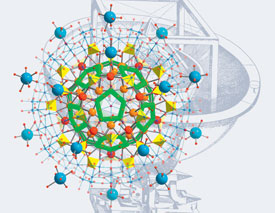An inorganic capsule that could be used to study cell functions has been developed by a team of German and US scientists.
Achim Müller, University of Bielefeld, Germany, and colleagues have made a capsule that allows specific cations to pass through its surface, akin to selective ion transport through pores in cell membranes.
The metal-oxide based capsule, called a keplerate, has a similar structure to a football and has a negatively charged core. Its key function is an ability to distinguish between different cations in solution explained Müller. 'Al3+ ions should have a high affinity for the capsule and its negatively charged cavity, but because these ions have strong interactions with water molecules they form complexes too large to enter, meaning Al3+ can only be found on the capsule surface or in solution. However, a cation such as Na+ with only weak interactions with water molecules can be found inside the cavity, even though it is less positively charged and larger,' he continued.

The capsules can be used as artificial cell models because they are structurally well defined and have a large inner cavity
|
The capsules can be used as artificial cell models because they are structurally well defined and have a large inner cavity. They can be used to model selective cation uptake in cells and to better understand biological transport through membranes. They can also be used to separate ions on a cellular scale. Future work could include doing coordination chemistry inside the capsules, on the surface and in the pores to adapt the model for different biological systems to be studied', said Müller.
The interesting thing is that these capsules are intrinsically very highly charged yet appear to be able to distinguish between different cations, said Lee Cronin an expert in nanoscale science from the University of Glasgow, UK. 'This is similar to ion gating found in biology and hence these models could have a great deal of potential as nanocell models, ion storage models and even in the construction of nanoscale molecular machines with valves that can be opened or shut according to the ion size and charge.'
Michele Zgraggen




